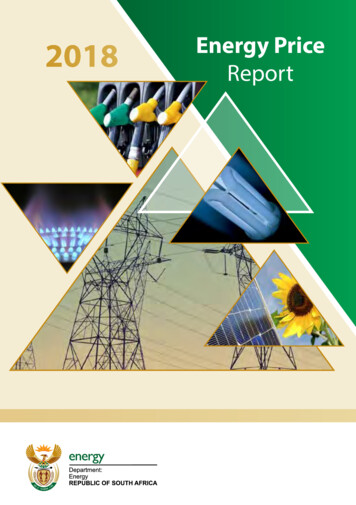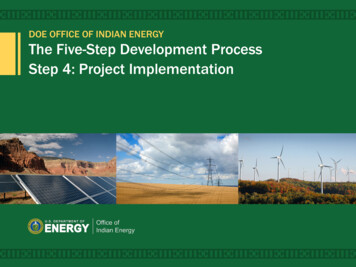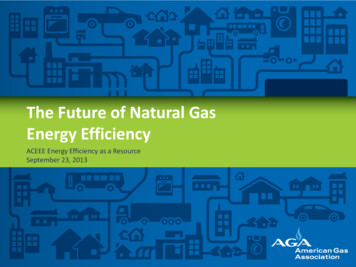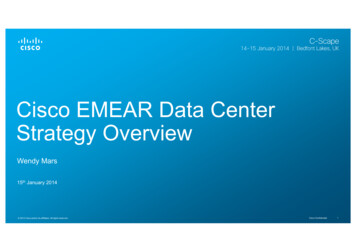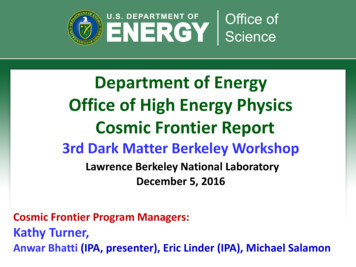
Transcription
Department of EnergyOffice of High Energy PhysicsCosmic Frontier Report3rd Dark Matter Berkeley WorkshopLawrence Berkeley National LaboratoryDecember 5, 2016Cosmic Frontier Program Managers:Kathy Turner,Anwar Bhatti (IPA, presenter), Eric Linder (IPA), Michael Salamon
Outline HEP MissionCosmic Frontier Program OverviewStatus of Current Dark Matter ProgramNear Future PossibilitiesHEP Program Planning and Budgets3rd Dark Matter Berkeley Workshop2
The High Energy Physics Program Mission is to understand how the universe works at its mostfundamental level:– Discover the elementary constituents of matter and energy– Probe the interactions between them– Explore the basic nature of space and timeThe Office of High Energy Physics fulfills its mission by:– Building projects that enable discovery science– Operating facilities that provide the capability toperform discovery science– Supporting a research program thatproduces discovery science3rd Dark Matter Berkeley Workshop3
The Science Drivers of Particle PhysicsThe Particle Physics Project PrioritizationPanel (P5) report identified five intertwinedscience drivers, compelling lines of inquirythat show great promise for discovery: Use the Higgs boson as a new tool for discovery*2013 Pursue the physics associated with neutrino mass Identify the new physics of dark matter*2015 Understand cosmic acceleration: dark energy and*2011inflation Explore the unknown: new particles, interactions,and physical principles* Since 2011, three of the five science drivers havebeen lines of inquiry recognized with Nobel Prizes3rd Dark Matter Berkeley Workshop4
HEP Research Subprograms Energy Frontier researchers accelerate particles to the highestenergies ever made by humanity and collide them to produceand study the fundamental constituents of matter and thearchitecture of the universeIntensity Frontier researchers use a combination of intenseparticle beams and highly sensitive detectors to make extremelyprecise measurements of particle properties, study rare particleinteractions, and search for new physicsCosmic Frontier researchers seek to reveal the nature of darkmatter and dark energy by using particles from space to explorenew phenomenaTheoretical and Computational Physics provide the frameworkto explain experimental observations and gain a deeperunderstanding of natureAdvanced Technology R&D fosters fundamental research intoparticle acceleration and detection techniques andinstrumentationAccelerator Stewardship coordinates with accelerator usercommunities and industry to develop innovative solutions tocritical problems, benefitting the broader user communities andthe discovery science3rd Dark Matter Berkeley Workshop5
COSMIC FRONTIER6
2014 P5 Strategic Plan Recommendations for Cosmic Frontier Dark Energy– Complete LSST as planned– Build DESI as a major step forward in dark energy science Dark Matter– Proceed immediately with a broad second-generation (G2)dark matter direct detection program (DM-G2) with capabilities described in the text Invest in this program at a level significantly above that called for in the 2012 joint agencyannouncement of opportunity– Support one or more third-generation (G3) direct detection experiments Guide G3 by the results of the preceding (G1, G2) searches Seek a globally complementary program and increased international partnership in G3experiments (DM-G3 Project is in the P5 plan in later part of their 10 year plan) Cosmic Microwave Background (CMB)– Support CMB experiments as part of the core particle physics program– The multidisciplinary nature of the science warrants continued multi-agency support(CMB-S4 Project is in the P5 plan, starting about mid-way through their 10 year plan) Cosmic Rays and Gamma Rays– Invest in Cerenkov Telescope Array (CTA) only if the critical NSF Astronomy funding can beobtainedCTA has a broad science reach that transcends fields, with the dark matter detection capabilities of direct importance to particlephysics; Using P5 Criteria, a de-scoped US component should be shared by NSF-AST, NSF-PHY and DOE.3rd Dark Matter Berkeley Workshop7
Cosmic Frontier StatusDark Energy: Staged program of complementary suite of imaging and spectroscopic surveys BOSS final results out soon; eBOSS, DES continue operationsLarge Synoptic Survey Telescope (LSST) received CD-3 in August 2015Dark Energy Spectroscopic Instrument (DESI) received CD-3 in June 2016Have MOA’s with NSF-AST for LSST partnership & DESI cooperationDark Matter (direct detection): Staged program of current and next-generation experiments with multipletechnologies Completed DOE operations funding for current DM-G1 experiments in FY 2016.Progress continues on DM-G2 experiments: ADMX-G2, LZ, SuperCDMS-SNOLAB––––ADMX-G2 infrastructure complete at UW; Science data taking operations started in August 2016.LZ & SuperCDMS-SNOLAB projects received Congressional “MIE starts” approval in FY 2015LZ received CD-2/3B in August 2016;SuperCDMS-SNOLAB received CD-1 December 2015Cosmic Microwave Background (CMB) South Pole Telescope polarization (SPTpol) continues operations.SPT-3G begins operations in Feb 2017; partnership with NSF.Community planning proceeding for CMB-S4 experiment; AAAC subpanel, CMB-S4 Concept, Definition Task force (CDT), being formed.Cosmic-ray, Gamma-ray Fermi/GLAST, AMS, and HAWC continue operations– HAWC gamma-ray observatory began full science operations in early 2015DOE operations funding completed in FY 2016 for VERITAS and Auger3rd Dark Matter Berkeley Workshop8
Axion Dark-Matter eXperiment (ADMX)Physics: Direct detection search for particle dark-matter made of axions: These arevery low mass (μeV to meV) hypothetical particles, predicted to solve a known issuewith QCD.Description: A strong magnetic field resonantly converts dark-matter halo axions intodetectable photons. Detector consists of a cryogenically-cooled microwave cavity in alarge superconducting 8 tesla magnet. Microwave photons are detected by an ultralow-noise SQUID/JPA-based microwave amplifier/receiver.DOE provides support to develop technology for a broadly sensitive search. Intend asdefinitive-sensitivity QCD dark matter axion search over broad mass range.Partnership: Primarily DOE support with contributions from the UK; R&D from HeisingSimons FoundationCollaboration: 25 scientists from 2 countries. LLNL, FNAL, U. of Washington, U. ofFlorida, UC Berkeley, NRAO, PNNL, LANL, Sheffield University (UK)HEP funding:U. Washington (experiment site), U. Florida, LLNL, FNAL.Status:Operates as a phased program with ADMX-2a operationscompleted in 2015; ADMX-G2 started fabrication at the end of FY14;ADMX-G2 science data taking started in August 2016.Operations review in Sept. 2016.Operation management moving to Fermilab.Recent Highlights: Featured in Scientific American (Sep 2015)axion mass (μeV)3rd Dark Matter Berkeley Workshop9
CDMS – Cryogenic Dark Matter SearchSuperCDMS-Soudan SuperCDMS-SNOLABPhysics: Direct detection of dark matter particles (WIMPs) using cryogenicsolid-state germanium and silicon crystals with sensors that detect ionizationand phonon signals. Sensitivity to very small energy depositions allowsadditional searches for axions and lightly ionizing particles.Description: SuperCDMS Soudan G1 WIMP experiment 2010-2015;SuperCDMS SNOLAB G2 low-mass WIMP experiment 2016-2025.Partnership: DOE and NSF, contributions from Canada (CFI, NSERC).Collaboration: 90 scientists from 13 US universities & 3 labs, plus institutionsfrom Canada, India, UK and Spain. D. Bauer (FNAL, Spokesperson)HEP funding: FNAL, SLAC, PNNL, Caltech, Minnesota, South Dakota, Stanford,Texas A&MProject: FNAL leads SuperCDMS-Soudan operations (D. Bauer);SLAC leads SuperCDMS-SNOLAB Project (B. Cabrera, Project Director)Status:SuperCDMS-Soudan operations completed in FY15; decommissioned in FY16;Analyses progressing.SuperCDMS-SNOLAB selected as one of three G2 Dark Matter experiments(July 2014); CD-1 approved December 2015. CD-2/3 review planned Nov.2017.Recent Highlights: (Oct 2016)New limit on low-mass WIMPS from CDMSlite Run 2 (black line and orangeband); x10 improvement at 3 GeV/c2 (http://arxiv.org/abs/1509.02448)Expect new results from CDMSlite Run 3 and additional SuperCDMS Soudananalyses early 2017.3rd Dark Matter Berkeley Workshop10
Large Underground Xenon (LUX) ZEPLIN LZPhysics: Direct detection of WIMPS through dual phase liquid Xe.Description: LUX - 350 kg liquid Xe at Sanford Underground ResearchFacility (SURF) in Davis cavern 4850’ underground. Minimum exclusionof 2.2 x 10-46 cm2 at 50 GeV WIMP (50 GeV). LZ - 7 tons of active Xenonand sensitivity near 2 x 10-48 cm2 , close to where astrophysical neutrinosbecome an irreducible background.Partnership: LUX: DOE & NSF partnership; contributions from UK,Portugal, Russia. LZ: DOE, UK, Korea, Portugal, Russia, SDSTA.Collaboration: LUX - 19 institutions; LZ - 31 institutions.HEP funding: LBNL (project office), LLNL, SLAC, Maryland, Rochester, Brown,LZTAMU, UC-Davis, UC-Santa Barbara, Washington U., Alabama, SUNY Albany, FNAL,Northwestern, South Dakota School of Mines & Technology, Texas A&M, WisconsinStatus:LUX: About 400 live days, stopped at end FY16; decommissioning inFY17LZ: Selected as one of three G2 Dark Matter experiments (July 2014);CD1/3a approved Apr 2015; CD2/3b approved Aug 2016;CD3 review planned Jan 2017.Recent Highlights: LUX: tightest limits on spin-independent cross-section LZ: LZ – cryostat, PMT, outer detector production and infrastructureupgrades at SURF underway. On track for 2020 operations start.LZ3rd Dark Matter Berkeley Workshop1111
Non-G2 WIMP Search ExperimentsPICO-60: Bubble chamber experiment at SNOlab (DOE, NSF, Canada)Status: Operations funded by Canada in 2017. PICO-60 running with C3F8 target liquid. R&D on nextgeneration bubble chambers with PICO-40L. Collaboration is proposing to Canadian agencies for ton-scaledetector.Highlights: Results in 2016 demonstrate world’s best sensitivity to spin-dependent WIMP scattering andcontinued progress on background reduction.DarkSide-50: LArTPC 50 kg active mass, Gran Sasso (LGNS), Italy(NSF-lead,major contribution from INFN, DOE)Status: Running with 153 kg of low-radioactivity underground Ar (UAr).Highlights: WIMP search results with 2616 kg-day UAr exposure (Oct 2015); Factor of 1000 reduction in39 Ar measured in the UAr compared to atmospheric Ar.DarkSide Collaboration planning to propose follow-on experiments:DarkSide-20k :20-tonnes fiducial mass; 100 ton-year - background-freeArgo: 300-tons depleted argon; start of operations at LNGS 2025DAMIC: Dark Matter in CCDs (DOE, NSF, 7 countries, operations at SNOLAB (Canada).Status: Preparing for the deployment of the 100g detector this year. The science detectors andelectronics are currently being testing in a final integration test at FNAL.Highlights: New results published with SNOLAB data in 2016 produced the best limits for low mass darkmatter search using silicon target. The collaboration published a full calibration of the ionization yieldof nuclear recoils in Silicon down to energies of 0.7 keV for the nuclear recoil in 2016.DOE operations funding for these experiments ended in FY16.3rd Dark Matter Berkeley Workshop12
Heavy Photon Search (HPS) Experiment at JLAB(Intensity Frontier)Physics: Search for a 20-400 MeV Dark Sector photon (A’) whichmay mediate dark matter interactions with regular matter and itsannihilations in Dark Matter halos.Description: High speed forward magnetic spectrometer usingsilicon vertex tracking with PbW04 crystal calorimeter fortriggering. Measures trident production in JLAB Hall B with 1-6GeV incident electrons, searching for A’s as a bump in the e einvariant mass spectrum and as detached vertices.Partnership: DOE HEP, DOE NP, IN2P3, and INFN partnership.Collaboration: 17 Institutions: SLAC, JLAB, Orsay, Saclay, INFN(6),Glasgow, UNH, ODU, UCSC, W&M, Yerevan, Stony BrookHEP Funding: SLAC, UCSC, Stony Brook, JLABStatus and plans: Completed engineering runs at 1.05 (2015) and2.3 GeV (2016). Preparing first bump hunt results for early 2017,and vertex results later in 2017. Planned SVT Upgrade will boostreach and be installed prior to an extended run, Summer 2018.Recent Highlights: First three Ph.D. theses completed (trident MC,bump hunt, vertex search). Demonstration of HPS physicsperformance led to full JLAB approval for 180 PAC days. 2018Summer run will be HPS’s first dedicated, protracted running.Detector Instrumentation papers being submitted to NIM.Bump2 PAC daysat 1 GeVVertex3rd Dark Matter Berkeley Workshop13
Dark Matter Future R&D (P5 recommendation) Limited funds are available for R&D towards Near term:– R&D efforts that support off-project efforts to help optimize the science ofthe DM-G2 experiments.– R&D efforts that are focused, low cost efforts to support the technologystudies for experiments that didn’t move to G2 and/or other technologieswhich have R&D that needs to be to done at this time. Longer term:– R&D efforts to develop technologies or concepts for possible G2 upgradeprojects.– R&D efforts to develop technologies or concepts towards G3’s.HEP received 8 proposals for FY17-19 funding; Under mail-in review;Decision expected early 2017.3rd Dark Matter Berkeley Workshop14
Cosmic Visions (CV) Groups – looking towards the future HEP has started “Cosmic Visions (CV)” groups inseveral areas: Allows interactions with small HEPcommunity groups as a 2-way line of communication for HEPfunded efforts.CV-CMB (Cosmic Microwave Background)Coordinate HEP technology R&D and other efforts for future CMBS4 planning.CV-DE (Dark Energy)Investigate future directions following the end of construction ofDESI and LSST; to complement, build on or extend theseexperiments in investigating the physics of dark energy.CV-DM (Dark Matter)Coordinate and investigate HEP technology R&D to optimizescience from DM-G2 experiments and for future DM-G3planning. Investigate new avenues for unexplored DM phasespace.3rd Dark Matter Berkeley Workshop15
New Opportunities in DM Searches (1) The search for dark matter (DM) was a high science priority in the 2014 P5 report. P5also had a recommendation about maintaining a diversity of project scales in theprogram (i.e. ensuring we have small projects too).It is important to cover all relevant phase space to the extent feasible. Currently, themajority of the current support and activity for dark matter search is aimed at WIMPand axion searches and is supported in the Cosmic Frontier. Some projects useaccelerator beams to search for particle which connects SM particles to dark sector, andare supported in the Intensity Frontier. LHC and other data are also used to search forDM candidates. There are also considerable theoretical studies of dark matter.To respond to the P5 recommendations above, HEP is interested in identifying new,small project(s) for dark matter searches in areas of parameter space (i.e. mass rangesor types of particles) not currently being explored.In order to move forward and to understand the possibilities, HEP needs input from thecommunity and is asking the community to organize a workshop in the March/April2017 timeframe. The workshop should examine the next step(s) for experimentation toexplore dark matter, including in unexplored areas of parameter space. It is expectedthat the workshop will result in a written white-paper report.3rd Dark Matter Berkeley Workshop16
New Opportunities in DM Searches (2)Whitepaper should be available around June 1, 2017 so that it can bean input for FY19 budget planning. Whitepaper should include:– Science case for unexplored the DM search phase space– Concept for small accelerator/non-accelerator projects to accomplishthese science goals Technologies and facilities needed Timescale (how long will it take to get ready and reach science goal)If there is a strong science case for new small project(s):– R&D funding for likely project(s) could start in FY18, if available. Determine the feasibility of the project– Proposals for the project(s) Review and possible funding, if available.These project(s) and associated facility development (if needed) maycost up to 10M .3rd Dark Matter Berkeley Workshop17
Concluding remarks Dark matter G2 program is progressing. HEP is committed tosupporting current G2 projects. This remains a priority. There is opportunity for funding for new small project(s) whichexpands the DM phase space over the phase space currentlybeing investigated within or outside HEP programs. New projectsmay be accelerator based. HEP would like to get community input on science case andstrawman concept for new small project(s) in form of awhitepaper by about June 1, 2017.3rd Dark Matter Berkeley Workshop18
ADDITIONAL MATERIAL ABOUT HEP19
Community Materials Steve Ritz is leading communityefforts to produce materials to helpmaintain the visibility of the P5report– Initial materials are available at:http://www.usparticlephysics.org/– Steve plans to continue working withthe U.S. particle physics communityto update the material as needed Users’ Groups report that Steve’smaterial was helpful during theirMarch 2016 visit to Washington, DC U.S. particle physics communityshould consider using Steve’smessages as part of theircommunications strategy3rd Dark Matter Berkeley Workshop20
HEP FY 2017 Budget OverviewEnergy Frontier: Continue to support leadership roles in the highlysuccessful LHC program– Initial LHC detector upgrade project funding ends in FY 2017– DOE Mission Need (CD-0) approved in April 2016 for the HL-LHC upgrades,P5’s highest priority near-term project R&D and developing TDRs for HL-LHC ATLAS and CMS now in-process Scope, roles and responsibilities continue to be firmed up– U.S. will continue to play a leadership role in LHC discoveries by remainingactively engaged in LHC data analysisIntensity Frontier: Solidify international partnerships for U.S.-hostedLBNF/DUNE– Rapid progress on LBNF/DUNE has attracted attention from interestedinternational partners and FY 2017 investments in site preparation andcavern excavation aim to solidify international partnerships– Fermilab will continue improvements to accelerator complex while servinghigh-intensity neutrino beams to short-and long-baseline experiments,enabling full utilization of the FNAL facilitiesCosmic Frontier: Advance our understanding of dark matter anddark energy– Fabrication funding ramp up in FY17 supports key P5 recommended CosmicFrontier projects to study dark matter and dark energy LSSTcam, DESI, SuperCDMS-SNOLab, LZHEP Program Status at HEPAP - December 201621
FY 2017 HEP Funding by ActivityFunding Category HEPadf( in K)FY 2015CurrentFY 2016EnactedFY 2017RequestExplanation of Changes (FY17 vs. FY16)Research334,225 327,389331,123 Sustain support for research programFacilities264,634 254,979252,037Overall operations support reductions dueto scheduled completion of projectsProjects99,373 107,620108,516*Other Project Costs (OPC) includes CDR, project-specific R&D, prototypingand testing, installation and commissioning/pre-operations before CD-4Initial ATLAS/CMS upgrades complete in18,967 FY17; OPC* begins for HL-LHC detectorupgradesEnergy Frontier Projects15,00019,000Intensity Frontier Projects48,17017,6859,349Cosmic Frontier Projects45,20366,83570,2001,0004,100Other ProjectsConstruction (Line 0* 795,000Reduction from ramp down of g-2 & end ofLBNF/DUNE OPC*; SBN Program increasesPlanned ramp up supports fabrication ofLSSTcam, DESI, SuperCDMS-SNOLab, LZ10,000 Increase to support the FACET-II projectRequest engineering design, site preparation103,741 and long-lead procurement for theLBNF/DUNE; planned profile for Mu2e22,580817,997 House mark 823M; Senate mark 833M* SBIR/STTR added to FY 2015 for comparison to FY 2016/20173rd Dark Matter Berkeley Workshop22
Overall HEP Budget TrendHouse mark 823MSenate mark 833MAll funding shown in “then-year” U.S. dollars Significant dip in FY 2013 from Congressional sequestrationFY 2015 request developed prior to P5 report releaseFY 2017 House/Senate markups increase project fundingFY 2017 CR through Dec. 9, 2016, at 791M equivalent annual level of fundingHEP Program Status at HEPAP - December 201623
The U.S. Federal Budget Cycle Typically, three budgets are being worked on at any given time This year’s cycle is not “typical”– Executing current Fiscal Year (FY; October 1 – September 30)– White House Office of Management and Budget (OMB) review and CongressionalAppropriation for coming FY– Agency internal planning for the second FY from now– Congress has not yet passed a budget for FY 2017 (see next slide )– DOE planning for FY 2018 has proceeded so far without guidance from the White HouseCongressionalBudget andAppropriationsCRSpend the Fiscal Year BudgetDOEFY 2018 DOE Internal Planning with OMBBudget OMB and OSTP Guidance ReviewBudget ReleaseFY 2017 OMBBudget ReviewBudget ReleaseFY 2016Spend the Fiscal Year BudgetBudgetCongressionalBudget andAppropriationsSpend the Fiscal Year BudgetOct Nov Dec Jan Feb Mar Apr May Jun Jul Aug Sep Oct Nov Dec Jan Feb Mar Apr May Jun Jul Aug Sep Oct Nov Dec Jan Feb Mar Apr May Jun Jul Aug SepCY 2015Calendar Year 2016Calendar Year 2017Calendar Year 2018You are hereHEP Program Status at HEPAP - December 201624
Duration of CRs: FY 1998 – FY 2017Fiscal YearOriginal Chart (FY 1998 – FY 2016) fromCongressional Research Service Report R42647,"Continuing Resolutions, Overview ofComponents and Recent Practices," 2016.201770 days through Dec. 9; 182 if extended to Mar. 31Continuing Resolution Duration (days)HEP Program Status at HEPAP - December 201625
Breaking the Cycle: Continuing Resolution If the U.S. Congress and the President have not passed all appropriations bills bySeptember 30, a Continuing Resolution (CR) may be passed to avoid a U.S.Government shutdown– Must pass some level of appropriations to have legal authority to spend money!– CRs typically extend level of funding from the previous year for a set amount of time A CR may impede the start of new projects A CR may impact the ramp-up of new projects A CR may also impact future-year planning through such effects Currently, an FY 2017 Continuing Resolution (CR) in effect through December 9, 2016 DOE has limited flexibility for adjustments under a CR, but will work closely withlaboratory and project management to minimize any impacts– Projects with total cost 10M must be line-items approved by Congress in an appropriationsbill before its “new start,” or its Total Estimated Cost (TEC) funding, can begin– It is possible, though not typical, for CRs to include “anomalies” that would allow new starts– DOE is committed to the successful execution of projects that have reached CD-2 and aims toprovide the baseline funding profile– Projects that have not reached CD-2 are most likely to be impacted under a CR– Funding through Dec. 9 equivalent to 791M level of funding, if extrapolated to full FY– Latest news suggests FY 2017 CR may be extended through March 31, 2017– More about CR impact on FOAs will be presented in Glen Crawford’s HEPAP talk tomorrowHEP Program Status at HEPAP - December 201626
DOE Project Management Construction projects and fabrication of large pieces of experimental equipment costing over 5M are managed through a series of “Critical Decision” milestonesThe CD process ensures successful project execution and scientific return on agencyinvestments, but funding must still be appropriated– Projects reaching CD-3 may have technical readiness, but they must be supported in thePresident’s Budget Request and receive funding from Congress before they can begin U.S. projects require use of U.S. accounting (contingency, labor, etc.) vs. CORE (M&S -project R&D)DOE 413.3B:CriticalDecisionsOperatingFundsTotal Project Cost (TPC)(R&D continues )CD-0ApproveMissionNeedIdentifies thereis a need that canonly be met thrumaterial needsCD-1ApproveAlternativeSelectionand Cost RangeEnsures theselected alternativeand approach is theoptimum solutionProjectCloseoutProject ost, scope, andschedulebaselines havebeen developedCD-3ApproveStart ofConstructionCD-4ApproveStart ofOperations(or Project Completion)Project hasdemonstratedtechnicalreadiness forimplementationProject is completedand ready forturnover toprogram operations3rd Dark Matter Berkeley Workshop27
Invest in this program at a level significantly above that called for in the 2012 joint agency . DOE NP, IN2P3, and INFN partnership. . Glasgow, UNH, ODU, UCSC, W&M, Yerevan, Stony Brook . HEP Funding: SLAC, UCSC, Stony Brook, JLAB. Status and plans: Completed engineering runs at 1.05 (2015) and 2.3 GeV (2016). Preparing first bump hunt .



